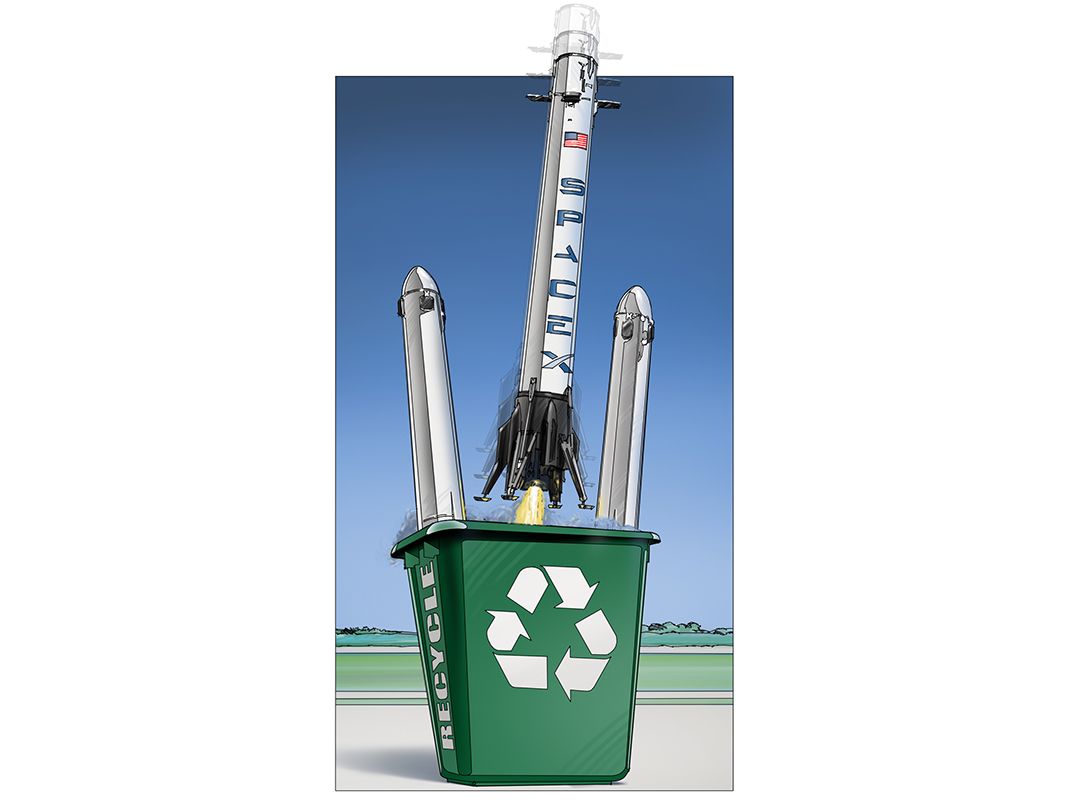Launch. Recover. Repeat
If Reusable Launch Vehicles become a reality, it won’t be thanks to NASA.
/https://tf-cmsv2-smithsonianmag-media.s3.amazonaws.com/filer/cb/03/cb030075-17f5-4ed7-a216-41d9b1a9a451/f9r-dev-05.jpg)
Launch. Recover. Repeat.
Elon Musk’s Company SpaceX started 2015 with an attempt to recover the first stage of its Falcon 9 rocket. If it succeeds—enough has been demonstrated so far to make that likely—SpaceX will become the first to launch a rocket-powered first stage to orbit, then land it under control.
The Falcon 9 will be the second partly recoverable launch vehicle. The first was the space shuttle, but it has been retired in favor of the expendable rockets it was supposed to replace. “Within a decade from now most of America’s inventory of conventional throwaway launch rockets will have been replaced by a more elegant and hopefully cheaper ladder to orbit,” reported Flight International in 1975, back before the orbiters had been built.
Some people will tell you that recovering a space launcher is so difficult that the economics can’t work, and use as evidence the failure of the shuttle to deliver its advertised savings and the collapse of other reusable spaceplane projects.
In my view, a few organizations could have made a reusable launcher work, and the reasons they failed were political rather than technical. The most influential of those organizations was NASA.
The space agency indeed wanted to replace all of America’s rockets. That goal required cooperation between NASA and the Pentagon, the latter fronting for the intelligence community. But the cooperation produced a shuttle designed to launch a huge spy spacecraft and return it on short notice; the shuttle ended up capable of carrying a 30-ton load and had big wings to make a long glide to its home base.
It was rather like the designers of the Douglas DC-3 setting out, in 1935, to build the Boeing 707. The first designs for fully reusable shuttles were monsters, so the goal was changed to partly reusable: A reusable orbiter was mated to a disposable external fuel tank and reusable solid boosters. Even so, the spacecraft’s airframe required untried, fragile materials to protect it from reentry heating.

By the time the Challenger broke apart on launch, on January 28, 1986, the Pentagon had walked away. The shuttle—now the world’s most expensive launch vehicle rather than its cheapest—was part of a NASA triad, together with the space station and human spaceflight. The station gave the shuttle a mission; together, the station and shuttle justified the astronaut corps. Human spaceflight meant political support, and all three programs supported a massive workforce.
It was logical that any new reusable launch vehicle (RLV) should be more economical than the shuttle. But new ideas were not evaluated against the real shuttle; they were compared to rosy promises of a safer and more efficient shuttle that would be developed a decade down the road.
The RLV effort was consequently based on the solution that offered the best economics of all: a single-stage-to-orbit (SSTO) vehicle. No assembly required; put the satellite in the payload bay, gas, and go. But it was beyond the state of the art. An SSTO had to either use a hypersonic air-breathing engine or be a rocket vehicle carrying ten times its weight in fuel. Two attempts to build an RLV—the McDonnell Douglas Delta Clipper and the NASA/Lockheed Martin X-33—had to compete with paper studies of better shuttles. Both were SSTOs and both failed.
A two-stage-to-orbit (TSTO) reusable vehicle has emerged from many design studies as a good tradeoff between performance and technical risk. The idea was looked at most seriously for a few years in the late 1990s. In 2001, NASA and the Air Force even formed a “OneTeam” to look at future RLVs, with all sorts of interesting concepts on the table, almost all of them unmanned TSTOs. But in February 2003 the shuttle Columbia was destroyed on reentry, confirming that the shuttle could never be made safe. NASA promptly switched its efforts to a future space program that preserved the shuttle industrial base, the space station, and its astronauts.
If SpaceX succeeds and can routinely recover undamaged boosters, the company will gain an economic advantage and inspire others to follow suit. But if an RLV becomes a reality, NASA—despite being the best funded space research agency in the world—will have had little to do with it.
/https://tf-cmsv2-smithsonianmag-media.s3.amazonaws.com/accounts/headshot/32_AM14_BillSweetman_head.jpg)
/https://tf-cmsv2-smithsonianmag-media.s3.amazonaws.com/accounts/headshot/32_AM14_BillSweetman_head.jpg)